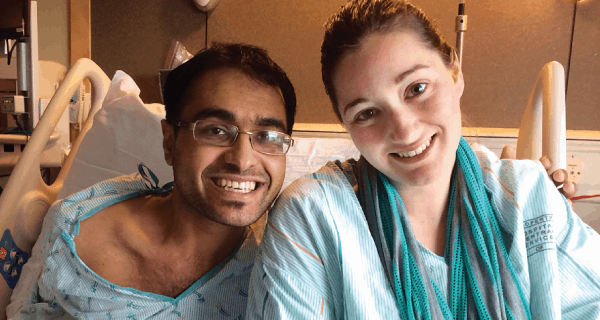“You see, Mr. Lucas,” says Mr. Castillo, “we’re not normal, us who do dialysis. It’s a hard life. We’re stuck. If we don’t come, we die.”
Every week I meet with dialysis patients like Mr. Castillo at a local hospital. These patients have been dealt a bad hand. Virtually all are poor. Many tell me they don’t have sufficient housing or enough money to buy proper food. Some lack social support. About half are immigrants who don’t speak English.
And to top it all off, they have kidney failure. They must sit for three hours/session, three times/week, while a machine removes blood from their bodies, filters it, and places it back in. Mr. Castillo wasn’t being dramatic: the machine is his kidney. Should he miss dialysis for two weeks (six sessions), he most likely would die.
Mr. Castillo has been doing dialysis for nine years. That’s over 1,400 sessions of dialysis — or 175 days of his life.
“You see, Mr. Lucas,” Mr. Castillo continues, “it’s a hard life. People don’t understand. You don’t know how hard it is.” He points to his arm where a fistula (access point for dialysis) has been created by stitching together a vein and artery.
I pause for a moment. Hesitating, I pull up the sleeve of my black clerical shirt to reveal I have a fistula too.
“Well Mr. Castillo,” I respond, “you are right. I cannot understand all the difficulties of your life. But I do know a little about the difficulties of living with kidney failure.”
***
Scene 1: Seattle L’Arche House – 1:00 pm
“I’m glad you called back so quickly,” said my new doctor in Seattle, “I got the results of your blood test. I think your kidneys are failing. You need to go to the 11th floor of the hospital immediately.”
Scene 2: 11th Floor Swedish Hospital Room – 2:00 pm
“Have you taken lots of Advil over the past few years? Chinese herbs? Drugs?” said the second doctor, a resident at the hospital.
My response: “No,” with a blank look of confusion.
“We’re going to give you an ultrasound,” responds the doctor. More confusion on my face. Aren’t ultrasounds only for pregnant women?
Scene 3: 11th Floor Swedish Hospital Room, Post-Ultrasound – 3:30 pm
“Hello, I am your doctor,” says the third doctor who walks in the door. “I’m here to go over the ultrasound results with you.”
She sat down on my bed. I should have known what was coming next wouldn’t be good.
“Your kidneys are operating at less than ten percent. We need to talk seriously about a transplant and options for dialysis.”
And so on a simple October afternoon in 2013, in a series of three scenes over a few short hours, I experienced a dramatic, life-altering rupture.
What followed was a series of doctors appointments, surgeries to install dialysis ports, new medication routines, diet changes, and a regular dialysis routine. I went from not knowing what a kidney does to calculating my every move in order to prolong my life. Overnight, I became a slave to a machine.
I was 26 at the time. I believed I was young and free. As a new Jesuit, I was full of enthusiasm to approach my new service placement at L’Arche. Sent for a period of time to accompany people with developmental disabilities, I became the one in need of accompaniment.

Fragility – From Flickr user Micolo J
Dialysis is not the only or the best treatment option. A kidney transplant is better. People who have kidney transplants live, on average, ten years longer than those who do dialysis. The reduced diet disappears. So does the attachment to the dialysis machine.
The one problem: not enough kidneys.
We are each born with two kidneys and only need one to live a healthy, full life. Healthy people can donate one of their kidneys to a friend or relative in need. For the recipient, it is the chance at a new life.
Currently, however, there are approximately 100,000 people waiting for a kidney transplant, but only 17,000 transplants actually happen per year. Many people become desperate, and sleazy businesses profit on an international kidney black-market. Recognizing these problems, researchers are experimenting with ways to allow any person to donate a kidney, regardless of compatibility.
***
One seemingly uneventful October day rapidly changed over the course of three hours. One day in early 2014 changed my life again – this time for the better – when my good friend from college, Megan, was deemed a kidney match.
“The kidney is yours,” she said with absolute freedom. “No questions asked.”
Today marks two years since Megan donated one of her two kidneys to me. After moderate recovery processes for both of us, we’ve continued our lives. Megan lives in San Francisco and is engaged to be married this summer. She has no residual effects of the surgery, except of course a great story where she is the heroine.
And for me – well, the slavery to that dialysis machine went away just as quickly as it came.
I no longer have the illusion of youthful independence. I’ve learned to humbly ask for help after having depended on my Jesuit community, family, and friends for everything. I accept the fragility of my own life.
I cannot help but be humbled that I am living a free life today because Megan, with no strings attached, offered herself.
***
Back at the dialysis center, I meet with Mrs. Jones. Her story bears some similarities to mine. After falling in the middle of the street suddenly, she was rushed to the hospital. Doctors told her the same shocking news: with her kidneys operating at less than 10%, she needed a kidney transplant.
Now, she’s in her third week at dialysis and is awaiting surgery to install the dialysis fistula. She’s already grown weary of the treatment, and it’s only been nine sessions. “I feel better already from the treatment, but…”
She stops.
“Everything here, it’s a lot to process, this new life problem… can I even do this for twenty years?”
She’s in her early fifties and otherwise is in good health, so I asked her if she’s considered a kidney transplant.
“My grandson wants to donate a kidney,” she explains hesitantly. “But he’s only twenty-two. He might need it. Oh, and my daughter also, but, well she might need it for her kids too.”
Working at the dialysis center, I’m not naive to think that the story will end happily for everyone I meet with. Should Mrs. Jones not get a kidney transplant – either because of the shortage, or because she doesn’t qualify for health or financial reasons – she’ll continue to come to dialysis three times a week until she dies. Mrs. Jones’s weariness from just three weeks fills me with the same uncertainties I grappled with. I am at a loss for words because I wonder how long it will be until she feels the same exhaustion that others like Mr. Castillo feel.
As I witness people like Mrs. Jones and Mr. Castillo come to terms with their fragility, I return to my own, though I must admit my life is a bit more stable. But it’s not guaranteed. I recognize my life could change again tomorrow. All I have is now. Sitting together at the dialysis center, their stories, hope, and resilience – like Megan’s kidney – become a part of me.


